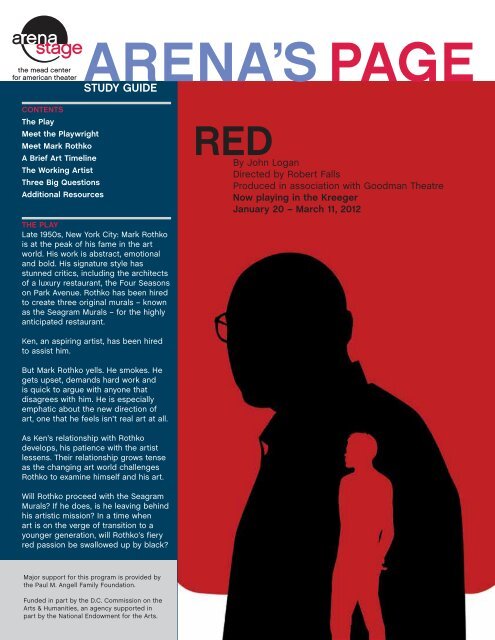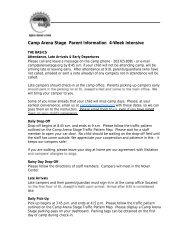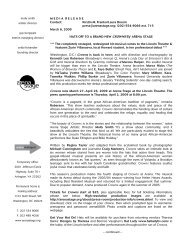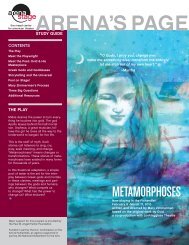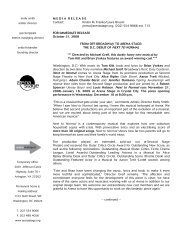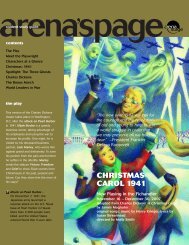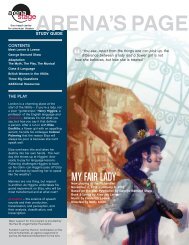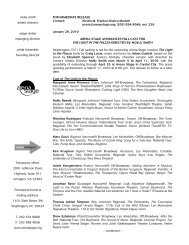Red Study Guide - Arena Stage
Red Study Guide - Arena Stage
Red Study Guide - Arena Stage
Create successful ePaper yourself
Turn your PDF publications into a flip-book with our unique Google optimized e-Paper software.
arena’s page<br />
study guide<br />
Contents<br />
The Play<br />
Meet the Playwright<br />
Meet Mark Rothko<br />
A Brief Art Timeline<br />
The Working Artist<br />
Three Big Questions<br />
Additional Resources<br />
<strong>Red</strong><br />
By John Logan<br />
Directed by Robert Falls<br />
Produced in association with Goodman Theatre<br />
Now playing in the Kreeger<br />
January 20 – March 11, 2012<br />
The Play<br />
Late 1950s, New York City: Mark Rothko<br />
is at the peak of his fame in the art<br />
world. His work is abstract, emotional<br />
and bold. His signature style has<br />
stunned critics, including the architects<br />
of a luxury restaurant, the Four Seasons<br />
on Park Avenue. Rothko has been hired<br />
to create three original murals – known<br />
as the Seagram Murals – for the highly<br />
anticipated restaurant.<br />
Ken, an aspiring artist, has been hired<br />
to assist him.<br />
But Mark Rothko yells. He smokes. He<br />
gets upset, demands hard work and<br />
is quick to argue with anyone that<br />
disagrees with him. He is especially<br />
emphatic about the new direction of<br />
art, one that he feels isn’t real art at all.<br />
As Ken’s relationship with Rothko<br />
develops, his patience with the artist<br />
lessens. Their relationship grows tense<br />
as the changing art world challenges<br />
Rothko to examine himself and his art.<br />
Will Rothko proceed with the Seagram<br />
Murals If he does, is he leaving behind<br />
his artistic mission In a time when<br />
art is on the verge of transition to a<br />
younger generation, will Rothko’s fiery<br />
red passion be swallowed up by black<br />
Major support for this program is provided by<br />
the Paul M. Angell Family Foundation.<br />
Funded in part by the D.C. Commission on the<br />
Arts & Humanities, an agency supported in<br />
part by the National Endowment for the Arts.
Meet the<br />
Playwright:<br />
Meet Mark Rothko<br />
(1903-1970)<br />
John Logan<br />
Born in San Diego in<br />
1961, John Logan is<br />
an award-winning<br />
playwright, screenwriter<br />
and producer. His parents<br />
are from Northern Ireland<br />
but immigrated to the U.S.<br />
via Canada. Logan grew<br />
up in California and New<br />
Jersey, then earned his<br />
degree from Northwestern<br />
University in 1983.<br />
An accomplished writer,<br />
Logan has received many<br />
of the highest awards for<br />
playwriting, including the<br />
Tony, Drama Desk, Outer<br />
Critics Circle and Drama<br />
League awards for <strong>Red</strong>.<br />
For Logan, <strong>Red</strong> marked a<br />
return to the stage after<br />
years of writing for movies<br />
and television. His original<br />
screenplays for the<br />
films Gladiator and The<br />
Aviator were nominated<br />
for Academy Awards.<br />
His screen adaptation<br />
of Sweeney Todd: The<br />
Demon Barber of Fleet<br />
Street starring Johnny<br />
Depp won a Golden Globe<br />
Award. Next year, Logan’s<br />
film Bond 23, another<br />
adventure for James<br />
Bond, will be released. l<br />
Mark Rothko<br />
Mark Rothko was born<br />
Marcus Rothkowitz<br />
in what is now<br />
Latvia. Rothko’s father<br />
moved his family to the U.S.<br />
in 1913. After his father died,<br />
Rothko started working in a<br />
factory at age 13.<br />
He received a scholarship<br />
to Yale but left early in his<br />
second year. He moved to<br />
New York City and dove<br />
deep into exploring and<br />
creating art.<br />
He changed his name<br />
to Mark Rothko in 1940<br />
because of growing anti-<br />
Semitism (anti-Jewish<br />
feelings) in the world.<br />
His work was influenced<br />
by mythology, drawing<br />
connections between<br />
ancient tales of barbarism<br />
and tensions in his world<br />
due to the Great Depression<br />
and World War II. Eventually,<br />
he decided mythology was<br />
outdated and did not help<br />
him express emotion.<br />
Later, after reading the<br />
philosophy of Friedrich<br />
Nietzsche, Rothko began<br />
to explore art’s ability to<br />
release the unconscious<br />
and explore complex<br />
emotion. He was having<br />
trouble using recognizable<br />
figures – like people and<br />
objects – to express the<br />
tragedy of the human<br />
condition. His work grew<br />
more abstract, representing<br />
subjects using symbols,<br />
shapes and colors.<br />
Friedrich<br />
Nietzsche,<br />
19th century<br />
German<br />
philosopher,<br />
challenged the<br />
foundations of<br />
Christian morality<br />
(right and wrong) and traditional<br />
mortality (human life and death).<br />
He believed in focusing on the<br />
present, rather than on any sort<br />
of afterlife. He is one of the<br />
many influences Rothko credits.<br />
In 1946, he pushed deeper<br />
into the abstract, using<br />
shape and color. At this point,<br />
his critical success and fame<br />
gave Rothko opportunities<br />
like painting the Seagram<br />
Murals seen in the play.<br />
Rothko’s Seagram Murals,<br />
National Gallery of Art,<br />
His colors started to grow<br />
darker. A brain aneurism<br />
in 1968 weakened his<br />
health and drove him into<br />
depression. In 1970 his<br />
assistant found him dead in<br />
the studio kitchen. He had<br />
committed suicide. l<br />
Fact<br />
Rothko had wanted to be an actor. Later he would say his<br />
paintings were plays, meant to be emotional conversations<br />
with the viewer, and that the color fields were the actors.<br />
An example of Rothko’s<br />
mythological images, The Syrian<br />
Bull, 1943, Allen Memorial Art<br />
Museum<br />
Becoming Rothko<br />
Activity: Edward Gero plays the role<br />
of Mark Rothko in <strong>Red</strong>. Read his blog,<br />
geroasrothko.wordpress.com, to see<br />
how he researched, rehearsed and<br />
transformed for the role.<br />
Photo by Liz Lauren.
A Brief Art Timeline<br />
Artists are influenced by the<br />
artists that come before<br />
them and the world around<br />
them. Here are the major<br />
movements leading up to and<br />
including the work of Rothko and<br />
the next generation of artists.<br />
Pablo Picasso, Three Musicians, 1921,<br />
Museum of Modern Art<br />
Cubism (1908-1919)<br />
Artists like Pablo Picasso<br />
The multiple angles and disjointed, broken<br />
and reassembled objects reflected a world<br />
that was growing complicated.<br />
Activity: View other<br />
examples of art from these<br />
“isms.” What changes from<br />
period to period What<br />
influences do you see What counterrevolutions<br />
In what other art forms<br />
do you see such changes over time<br />
(e.g., music)<br />
Research by Kate Coughlin<br />
Marcel Duchamp, L.H.O.O.Q., 1919, private collection<br />
Dadaism (1916-1920s)<br />
Artists like Marcel Duchamp<br />
Artists showed their dissatisfaction with a war-torn world and art by making<br />
random art that showed nothing and meant nothing. It was “anti-art.”<br />
Salvador Dalí, The Persistence of Memory,<br />
1931, Museum of Modern Art<br />
Surrealism (1920-1930s)<br />
Artists like Salvador Dalí<br />
The real world was harsh and controlling, so<br />
artists created a new world of dreams and<br />
strange comparisons.<br />
Jackson Pollock, Number 1, 1950,<br />
National Gallery of Art<br />
Abstract Expressionism (1940-1960s)<br />
Artists like Jackson Pollock & Mark Rothko<br />
Art was non-representation – it was not meant<br />
to be something but meant to mean something.<br />
Shapes and colors were meant to ignite an<br />
emotional experience.<br />
Activity: Color is significant and symbolic, and humans respond to it<br />
emotionally. Make a list of colors and then discuss what the colors mean<br />
or evoke. Hypothesize: why is the play entitled <strong>Red</strong><br />
Read more about color and other themes and information connected to <strong>Red</strong> at<br />
Sub/Text: Your Virtual Dramaturg at www.arenastage.org.<br />
Andy Warhol, Campbell<br />
Soup 1, 1968, Kerry Stokes<br />
Collection<br />
Pop Art (1950-1960s)<br />
Artists like Andy Warhol<br />
Artists challenged the<br />
elitism in fine art and<br />
used imagery from current<br />
culture, like advertisements,<br />
cartoons and celebrities.
People often picture artists as<br />
people who live and work in their<br />
warehouse apartments, who create<br />
works of art, alone, at all hours of day,<br />
whenever inspiration strikes.<br />
However, Mark Rothko, like many other<br />
artists, made his art like going to work<br />
each day. Rothko arrived at his studio<br />
around 8:45 a.m. and changed into his<br />
painting clothes (his assistant during<br />
the Seagram Murals, Dan Rice, said the<br />
clothes could practically stand up on<br />
their own). He left at the end of the day.<br />
Three Big Questions<br />
ONE. How is <strong>Red</strong> a<br />
story of generations,<br />
even of fathers and<br />
sons<br />
two. What makes<br />
something “art”<br />
Additional Resources<br />
Books<br />
The Artist’s Reality: Philosophies on Art by Mark Rothko, 2006.<br />
The Essential Mark Rothko by Klaus Ottmann, 2003.<br />
On the Web<br />
Phillips Collection: “Mark Rothko: Ochre on <strong>Red</strong> on <strong>Red</strong>”<br />
www.phillipscollection.org/research/american_art/learning/rothko-learning.htm<br />
Phillips Collection: “Audio Tour of Mark Rothko: Green and Maroon” www.phillipscollection.org/collection/audio-tour/<br />
National Gallery of Art: “Mark Rothko” www.nga.gov/feature/rothko/rothkosplash.shtm<br />
MoMA Learning: “What is Abstract Expressionism: Mark Rothko” education.moma.org/<br />
moma/learningresources/cms_page/view/366521<br />
Film<br />
The Power of Art: Rothko, a Documentary: BBC, 2006.<br />
Museums<br />
To see Rothko’s work in Washington, D.C., consider visiting:<br />
The National Gallery of Art<br />
The Phillips Collection<br />
The Working<br />
Artist<br />
Though Ken is fictional, Rothko, like<br />
many other artists, had assistants.<br />
Artists’ assistants’ work varies based<br />
on the artist they work with. Tasks<br />
might include preparing materials,<br />
making food, research, installing and<br />
dismantling work, and running errands.<br />
Rothko’s assistant helped stretch<br />
canvasses and applied base layers of<br />
treatment and paint.<br />
Artist’s assistants are often artists<br />
themselves, helping another artist until<br />
they establish their own body of work. l<br />
Photo by Liz Lauren.<br />
three. <strong>Red</strong> explores<br />
opposites/dualities (e.g., red<br />
vs. black); how are they significant<br />
to the play<br />
Helpful Hints for Theater Audiences<br />
As an audience member at the theater,<br />
YOU are part of the show! Just as you<br />
see and hear the actors onstage, they<br />
can see and hear you in the audience.<br />
To help the performers do their best,<br />
please remember the following:<br />
Arrive at least 30 minutes early.<br />
Visit the restroom before the show starts.<br />
Before the show begins, turn off your<br />
cell phone, watch alarms, pagers<br />
and other electronic devices. If<br />
anything rings by accident, shut it off<br />
immediately.<br />
Save food and drinks for the lobby.<br />
There is no eating or drinking inside<br />
the theater.<br />
Walk to and from your seat - no<br />
running in the theater!<br />
Do not talk, whisper, sing or hum.<br />
Do not use cell phones for calls, text<br />
messages, pictures or games.<br />
Keep your feet on the floor, not on<br />
the seat in front of you.<br />
Avoid getting up during a show<br />
because it distracts your neighbors<br />
and the performers. If you must leave,<br />
wait for a scene change, then exit<br />
quietly and quickly.<br />
Performers appreciate enthusiastic<br />
applause rather than whistling or<br />
shouting.<br />
Cameras and videotape are<br />
prohibited because they are<br />
distracting to the performers.<br />
Enjoy the show!<br />
1101 Sixth St., SW<br />
Washington, DC 20024<br />
Phone: 202-554-9066<br />
Fax: 202-488-4056<br />
Written by Fareed Mostoufi<br />
Edited by Rebecca Campana<br />
Special thanks to the Phillips<br />
Collection and the National Gallery<br />
of Art.<br />
Illustration by Ulla Puggaard<br />
Visit www.arenastage.org<br />
for more information on<br />
<strong>Arena</strong> <strong>Stage</strong> productions<br />
and educational opportunities.


